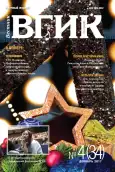Contemporary Hero in the Wartime Chronotope
- Authors: Muradov A.B1, Shergova K.A2
-
Affiliations:
- Московский государственный институт культуры
- Академия медиаиндустрии
- Issue: Vol 9, No 4 (2017)
- Pages: 37-50
- Section: FILM LANGUAGE AND TIME | IMAGE GENESIS
- URL: https://journals.eco-vector.com/2074-0832/article/view/14615
- DOI: https://doi.org/10.17816/VGIK9437-50
- ID: 14615
Cite item
Full Text
Abstract
The focal point of the analysis are Tatiana Lioznova’s TV-series 17 Moments of Spring. This notable Great Patriotic War movie presents a protagonist that partakes spring 1945’ events not as a historical, distanced personality but as a contemporary of the time of the release. This statement is supported with three-layered analysis of the character presentation. The initial layer of analysis implies that Stierlitz character (a Soviet spy, acting deep undercover within the highest ranks of Nazi Germany) develops an idealized presentation of an intelligence officer as in earlier Soviet films. The character does not provide a viewer with the option of self-identification, becoming an archetype - this conversion allocates the story to an epic space, not a historical context. Considering Stierlitz’ character as a super-spy, a loner implies a second layer of interpretation: a contest-comparison with the most known espionage character of the 20th century, James Bond. Meanwhile the creator shape Stierlitz rather pretentious anti-Bond, they use numerous specific tools to accentuate the difference. Among those we point a “time theme” that plays an important part in storytelling and general film design (“time” is present in the series title, it repeatedly returns in soundtrack, and notoriously present in the character’s persistent slowness). A few other details involve a third layer of the character’s interpretation: Stierlitz embodies contemporary image of a 1960-1970’s Soviet technical intelligentsia - in terms of the release “a hero of our time”. Multilayered interpretation of the Stierlitz character provides 17 Moments of Spring a very specific place in the history of Soviet television and film production. Tatiana Lioznova used a number of creative methods that allowed her to bridge 1945’ events with her contemporaries and to significantly contribute into the Soviet archetypal construction.
About the authors
Aleksey B Muradov
Московский государственный институт культуры
Author for correspondence.
Email: editor@vestnik-vgik.com
Associate Professor, Head of Cinema Department (Moscow State Institute of Culture), author, producer and director
Ksenia A Shergova
Академия медиаиндустрии
Email: editor@vestnik-vgik.com
PhD in Arts, Associate Professor of Screen Arts Department (Moscow Media Industry Academy)
References
- Адамович М. «Не думай о “Мгновеньях” свысока» // Искусство кино, № 3, 2002. - С. 74-85.
- Белоусов А.Ф. Анекдоты о Штирлице // Живая старина, № 1, 1995. - С. 16-19
- Липовецкий М. Искусство алиби: «Семнадцать мгновений весны» в свете нашего опыта // Неприкосновенный запас, № 3, 2007 // URL: http://magazines.russ.ru/nz/2007/3/H16.html (дата обращения: 31.03.2017).
- Лихачев Д.С. Эпическое время былин / Поэтика древнерусской литературы. - М.: Наука, 1979. - 360 с.
- Павлов В.Г. Операция «Снег». - М.: Гея, 1996. - 272 с.
- Санников В.З. Русский язык в зеркале языковой игры / Языки славянской культуры. - М.: Кошелев, 2002. - 547 с.
- Эко У Роль читателя. Исследования по семиотике текста. - М.: Изд-во РГГУ, 2005. -502 с.
- Chapman J. Licence to thrill: a cultural history of the James Bond films. NY, NY. 2007. - 336 p.
- Lovell S., 'In Search of an Ending: Seventeen Moments and the Seventies' / The Socialist Sixties: Crossing Borders in the Second World. Indiana University Press, 2013. - P. 303-321
Supplementary files








